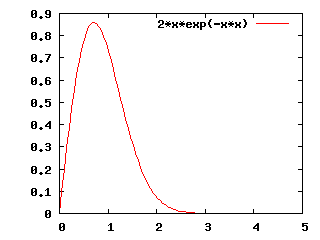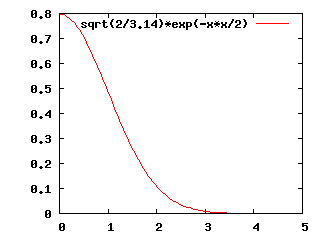Centric and acentric reflections: Difference between revisions
No edit summary |
|||
| Line 40: | Line 40: | ||
Furthermore, the "intensity statistics" [2] of acentric reflections | Furthermore, the "intensity statistics" [2] of acentric reflections | ||
(<math> P(|E|) = 2 |E| e^{-|E|^2} </math> ) | (<math> P(|E|) = 2 |E| e^{-|E|^2} </math> ) | ||
[[file:I_acentrics.png]] | |||
are different from those of centric reflections | are different from those of centric reflections | ||
(<math> P(|E|) = \sqrt{\frac{2}{\pi}} e^{-|E|^2/2} </math> ) | (<math> P(|E|) = \sqrt{\frac{2}{\pi}} e^{-|E|^2/2} </math> ) | ||
[[file:I_centrics.png]] | |||
. | . | ||
Revision as of 16:34, 8 March 2016
Centric reflections play the same role in reciprocal space as special positions in real space: they may occur at the borders of the asymmetric unit. It makes sense to discuss the reciprocal case and the real space together.
A definition and a theorem about centric reflections are stated here (see reference [1]) before the role of centrics is examined.
Definition: A reflection (h,k,l) is said to be centric if in the space group there is at least one symmetry operation g(x)=R_g*x+t_g whose rotational part R_g sends the reflection to minus itself, i.e.:
(h,k,l) is centric if there is a symop g(x)=R_g*x+t_g in G such that R_g*(h,k,l)=(-h,-k,-l)
For example all reflection in the zone (h,k,0) are centrics in all space groups with twofold axes down c.
Theorem: The phase of a centric reflection is restricted to phi(h,k,l)=pi*(h*tx_g+k*ty_g+l*tz_g) plus or minus any integer multiple of pi
where the vector t_g=(tx_g,ty_g,tz_g) is the translational part of the symop g that causes the reflection to be centric.
Real space
Let's first look at real space. A special position results if there exists one or more symmetry operators, other than the trivial operator {x,y,z}, which map this position upon itself. As an example: take spacegroup P2 with its symmetry operators {x,y,z} and {-x,y,-z}. Now consider any point with x=0 and z=0, and some value of y. Obviously this point, when transformed with -x,y,-z , yields 0,y,0 - just the same point! Thus this is a special position. Generally, positions on n-fold symmetry axes are special.
Mathematically, to find special positions we have to solve the Eigenproblem A v = v where A is the symmetry operator (expressed as rotation matrix and translation vector), and v, the Eigenvector, represents the special position(s). For a given space group, we need to check all symmetry operators.
An atom at a special position usually has (at most) an occupancy of 0.5. However, it may happen that more than one symmetry operator maps the special position upon itself; in that case the occupancy is 1/(number of positions generated by all symmetry operators that map the point onto itself). Thus, a point on a n-fold rotation axis has (maximum) occupancy of 1/n. Disorder or partial occupation will result in lower occupancy.
In space group P21, there are no special positions - the Eigenproblem has no solution.
Reciprocal space
In reciprocal space the situation is quite similar. A reflection is centric if there is a reciprocal space symmetry operator which maps it onto itself (or rather its Friedel mate). Reciprocal space symmetry operators can be obtained from the real space symmetry operators by following two rules:
a) take the rotation matrix and transpose it
b) omit the translation vector
Whereas rule b) makes things slightly easier in reciprocal space, we must be aware that in reciprocal space we have additional symmetry, namely Friedel symmetry. This means for each reciprocal symmetry operator we also have to consider the Friedel-related operator (all elements of the matrix multiplied by -1).
To find centric reflections, we just solve the Eigenvalue problem A v = -v, now considering each reciprocal space symmetry operator in turn. Centric reflections in space group P2 and P21 are thus those with 0,k,0. There exist space groups without centric reflections, like R3.
Properties: centric reflections have only two phase possibilities, e.g. 0° and 180° (but in any case 180° apart), and centric reflections do not have an anomalous signal (can these properties be easily derived here?).
Furthermore, the "intensity statistics" [2] of acentric reflections ([math]\displaystyle{ P(|E|) = 2 |E| e^{-|E|^2} }[/math] )
are different from those of centric reflections ([math]\displaystyle{ P(|E|) = \sqrt{\frac{2}{\pi}} e^{-|E|^2/2} }[/math] )
Centric reflections have a special role in experimental phasing.
References
[1] G. Bricogne, "Fourier Transforms in Crystallography", page 68, Chapter 1.3, International Tables for Crystallography Volume B, Kluwer Publishers (2001)
[2] U. Shmueli and A. J. C. Wilson, "Statistical properties of the weighted reciprocal lattice", page 190-209, Chapter 2.1, International Tables for Crystallography Volume B, Kluwer Publishers (2006)

